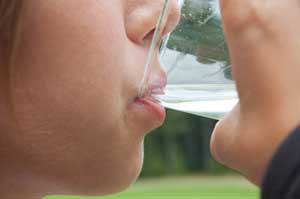Ahhh... Does a body good...
The hottest days of summer are likely behind us. We had some great weather and some days when it was so hot we shut down practices. Many of us don't pay enough attention to hydration - which is too bad, because when we're well hydrated we feel better, our body works better, and we perform better on and off the field.
Even though we're heading into cooler months, a reminder about hydration doesn't hurt.
The U.S. Youth Soccer Federation provides these guidelines to help parents, players and coaches prevent dehydration and heat illness in young athletes who are active in the heat:
1) Encourage each player to weigh before and after activity to determine how much fluid was lost during activity. If a player is lighter after activity then encourage a little more fluid consumption during the next practice/game. If the player is heavier after activity then encourage a little less fluid during the next practice/game. Players should try to limit fluid losses to 1-2% of body weight or less.
2) According to the American Academy of Pediatrics:
- Before prolonged physical activity, the child should be well hydrated.
- During the activity, periodic drinking should be encouraged even if the child does not feel thirsty. Each 15-20 minutes the child or adolescent should consume:
− 9 ounces of fluid for a player weighing more than 90 lbs.
The medical research further suggests:
- To ensure that the child is not dehydrated before the start of the practice session or game, the child should drink 12-16 ounces of fluid approximately 30 minutes before getting to the field.
- Once the activity is over, players should drink water or a sports drink every 15-20 minutes for the first hour after activity. The rate of fluid ingestion is generally 1.5 pints of fluids for each pound of weight lost. Volume overload can make it difficult for some athletes to fully rehydrate between multiple sessions within a single day. The goal is to begin training each day at the same weight.
- Recent research shows that adolescent males typically lose 1-1.5 liters per hour when performing intense soccer practices/games in the heat, while younger males and females will lose from 0.6 to 1 liter per hour.
- If their urine (during flow, not once the urine is diluted in the bowl) is a pale yellow, like lemonade, then they are likely pretty well hydrated. If their urine is dark yellow, like apple juice, then they are likely dehydrated. This is an easy and accurate way to assess hydration status and it gets the kids involved on a personal level.
- Flavored beverages that contain sodium (sports drinks) are preferable because the child may drink more.
- Research shows that lightly sweetened and flavored non-carbonated beverages, like sports drinks, are preferred during exercise and are consumed in greater volumes than water,12 diluted fruit juice13 or carbonated beverages14.
- Research shows that fluids containing sodium chloride (sports drinks) increase voluntary drinking by 90%, compared to drinking plain water.
6) Immediately before and during activity, children should avoid fruit juices, carbonated beverages, caffeinated beverages and energy drinks.
- Fruit juices have a high sugar content that can slow fluid absorption, cause an upset stomach, and may also lack sodium.
- Carbonated beverages, such as soft drinks, can reduce voluntary drinking due to stomach fullness, throat burn when gulping and lack sodium.
- Energy drinks should be avoided because many contain caffeine and have high carbohydrate concentrations which slows the emptying of fluids from the stomach.
Here's a link to the complete U.S. Soccer Federation's 2006 Youth Soccer Heat & Hydration Guidelines.
Drink up!










No comments:
Post a Comment